Abstract
1. The effects of nitric oxide (10(-6) M), N omega-nitro-L-arginine methylester (L-NAME, 10(-4) M, an inhibitor of nitric oxide synthase), endothelium removal, hypoxia and selective alpha-adrenoceptor antagonists on responses to nerve electrical field-stimulation (EFS) were studied in the rabbit isolated pulmonary artery. 2. EFS induced frequency-dependent contractions which were abolished by prazosin (alpha 1-adrenoceptor antagonist) and unaffected by rauwolscine (alpha 2-adrenoceptor antagonist). EFS-induced responses were potentiated by L-NAME and inhibited by nitric oxide. The effect of L-NAME was reversed by the presence of L-arginine (2 x 10(-4) M), which had no effect on its own. In the presence of L-NAME, the EFS-induced responses were reduced by rauwolscine and the residual responses were abolished by prazosin. 3. Removal of the vascular endothelium increased the maximum contractile response to EFS but did not inhibit the ability of L-NAME to potentiate contractile responses to EFS. 4. Hypoxia inhibited the contractile response to EFS. This effect of hypoxia was also seen in the presence of L-NAME and in endothelium rubbed preparations. 5. In conclusion, the endothelium modulates EFS-induced contractions in the rabbit pulmonary artery. The contraction induced by EFS was inhibited by nitric oxide, but potentiated by the nitric oxide-synthase inhibitor, L-NAME. The effect of L-NAME was not mediated solely through the endothelium and revealed involvement of alpha 2-adrenoceptors in EFS-induced contraction. Hypoxia inhibited neurogenic responses in rabbit isolated pulmonary arteries.
Full text
PDF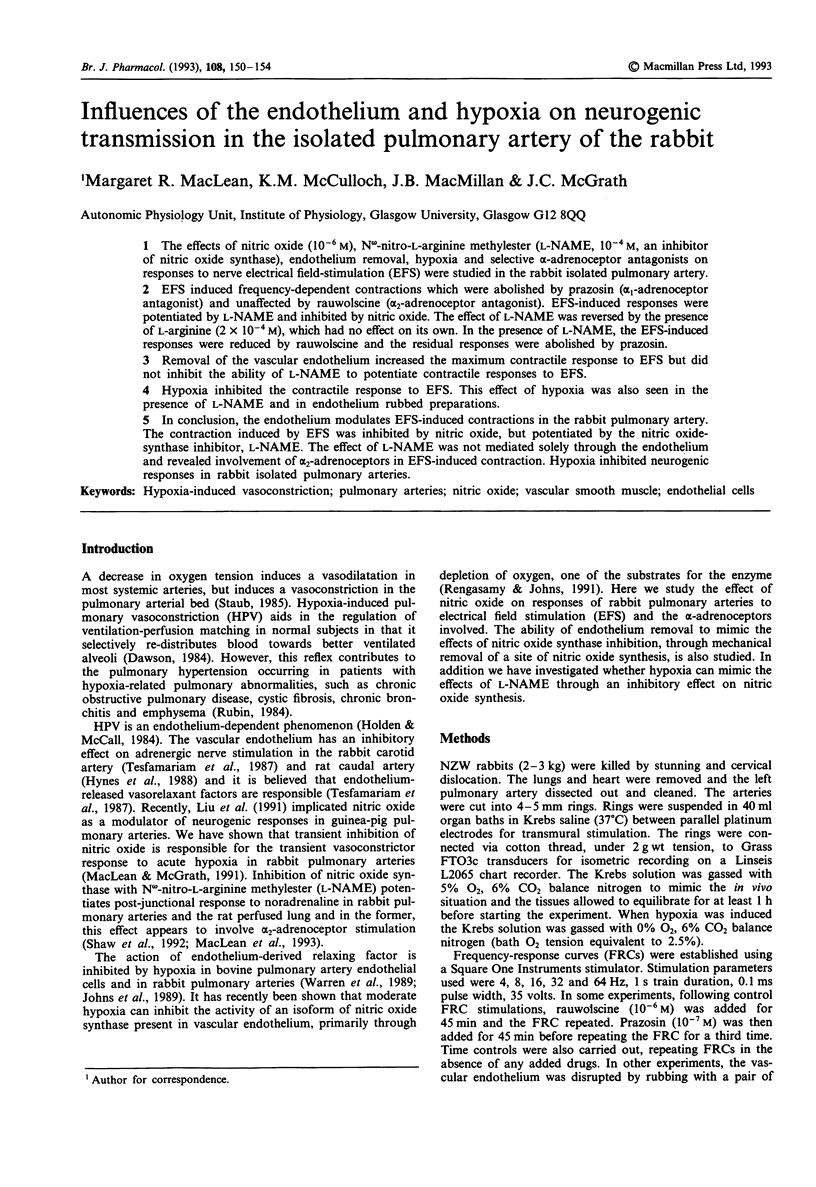
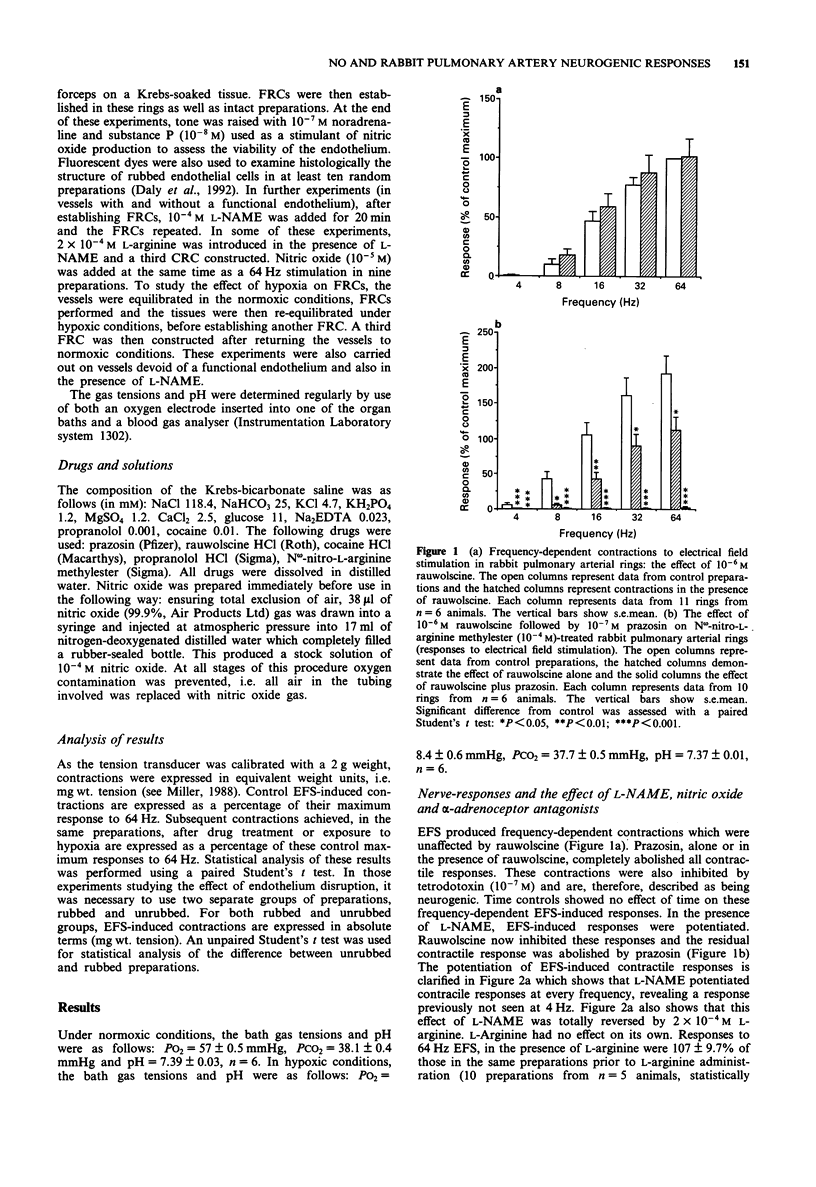
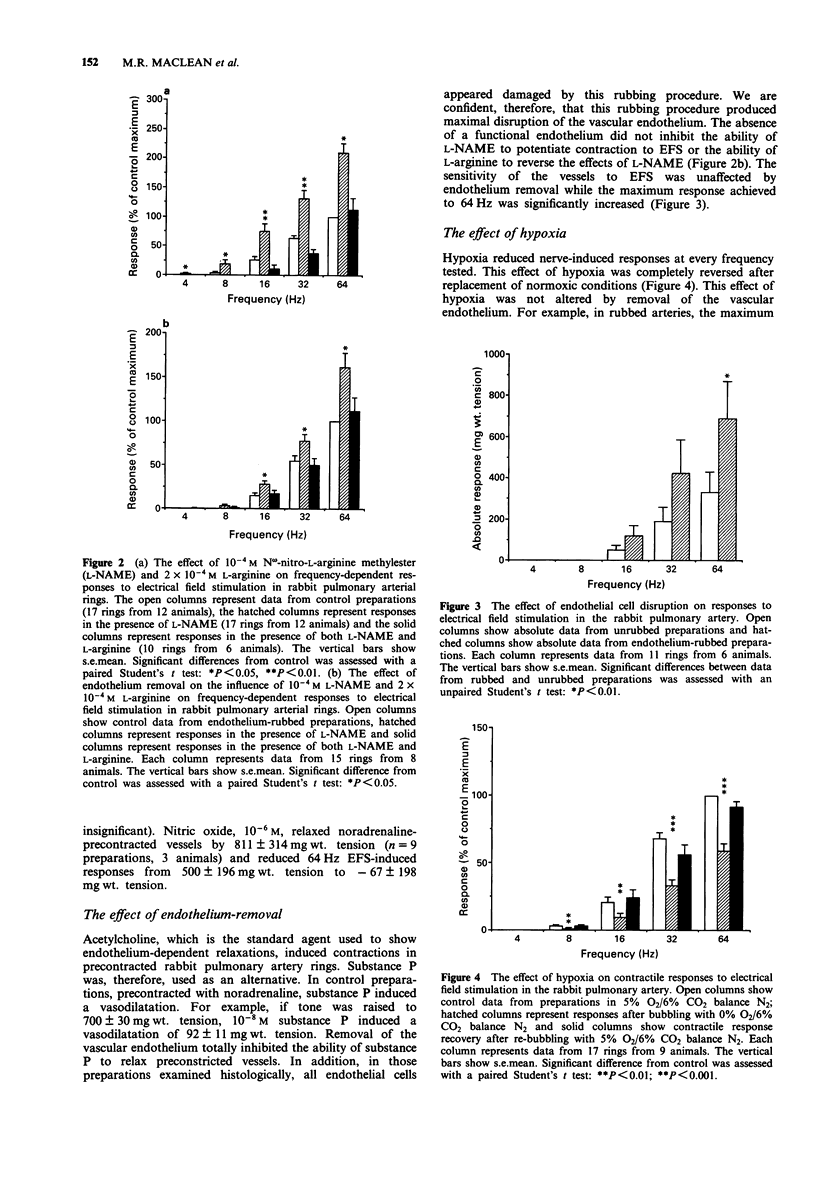
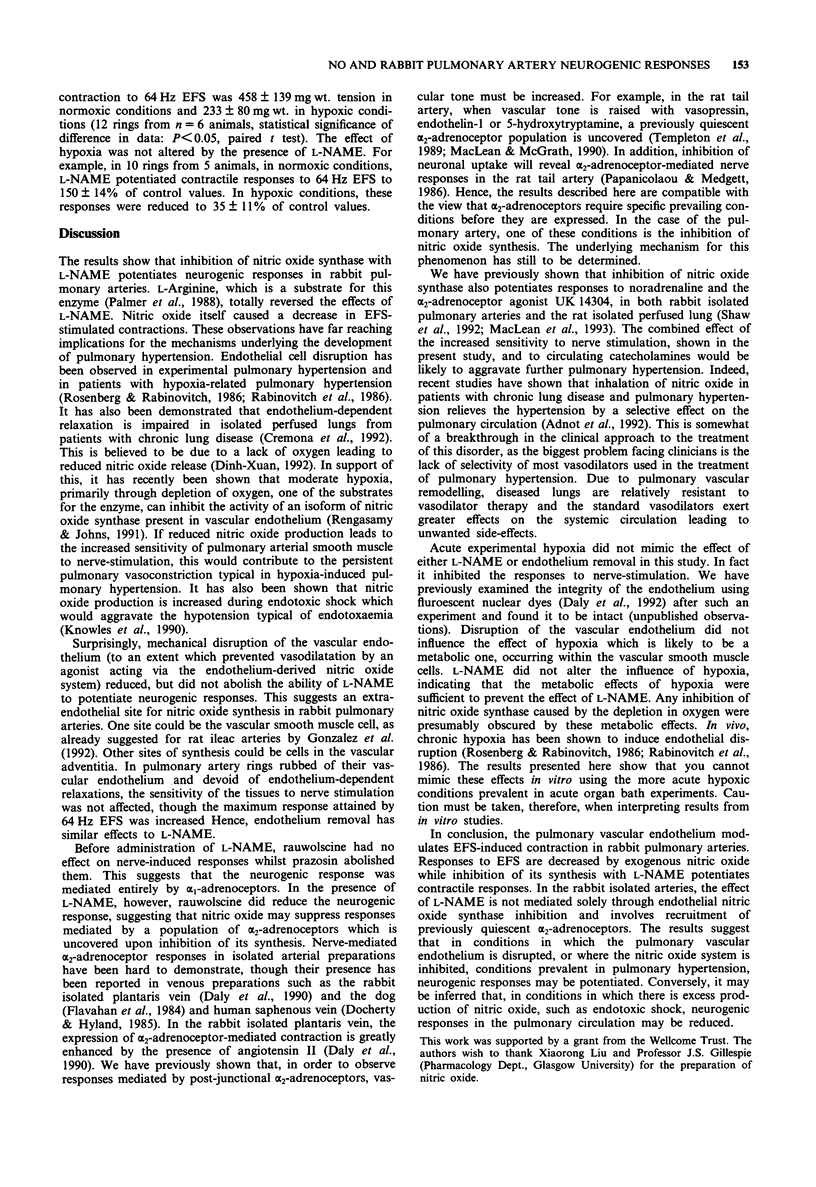
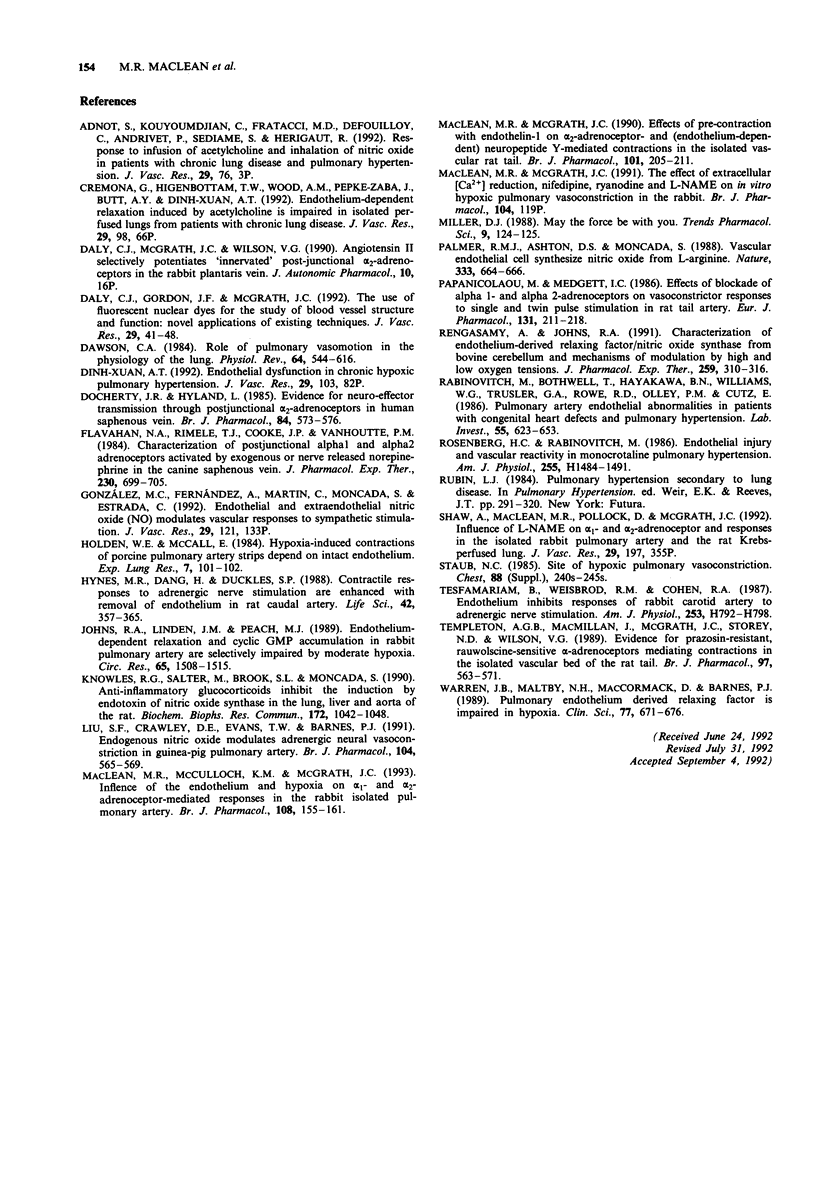
Selected References
These references are in PubMed. This may not be the complete list of references from this article.
- Daly C. J., Gordon J. F., McGrath J. C. The use of fluorescent nuclear dyes for the study of blood vessel structure and function: novel applications of existing techniques. J Vasc Res. 1992 Jan-Feb;29(1):41–48. doi: 10.1159/000158930. [DOI] [PubMed] [Google Scholar]
- Dawson C. A. Role of pulmonary vasomotion in physiology of the lung. Physiol Rev. 1984 Apr;64(2):544–616. doi: 10.1152/physrev.1984.64.2.544. [DOI] [PubMed] [Google Scholar]
- Docherty J. R., Hyland L. Evidence for neuro-effector transmission through postjunctional alpha 2-adrenoceptors in human saphenous vein. Br J Pharmacol. 1985 Feb;84(2):573–576. doi: 10.1111/j.1476-5381.1985.tb12942.x. [DOI] [PMC free article] [PubMed] [Google Scholar]
- Flavahan N. A., Rimele T. J., Cooke J. P., Vanhoutte P. M. Characterization of postjunctional alpha-1 and alpha-2 adrenoceptors activated by exogenous or nerve-released norepinephrine in the canine saphenous vein. J Pharmacol Exp Ther. 1984 Sep;230(3):699–705. [PubMed] [Google Scholar]
- Holden W. E., McCall E. Hypoxia-induced contractions of porcine pulmonary artery strips depend on intact endothelium. Exp Lung Res. 1984;7(2):101–112. doi: 10.3109/01902148409069671. [DOI] [PubMed] [Google Scholar]
- Hynes M. R., Dang H., Duckles S. P. Contractile responses to adrenergic nerve stimulation are enhanced with removal of endothelium in rat caudal artery. Life Sci. 1988;42(4):357–365. doi: 10.1016/0024-3205(88)90073-2. [DOI] [PubMed] [Google Scholar]
- Johns R. A., Linden J. M., Peach M. J. Endothelium-dependent relaxation and cyclic GMP accumulation in rabbit pulmonary artery are selectively impaired by moderate hypoxia. Circ Res. 1989 Dec;65(6):1508–1515. doi: 10.1161/01.res.65.6.1508. [DOI] [PubMed] [Google Scholar]
- Knowles R. G., Salter M., Brooks S. L., Moncada S. Anti-inflammatory glucocorticoids inhibit the induction by endotoxin of nitric oxide synthase in the lung, liver and aorta of the rat. Biochem Biophys Res Commun. 1990 Nov 15;172(3):1042–1048. doi: 10.1016/0006-291x(90)91551-3. [DOI] [PubMed] [Google Scholar]
- Liu S. F., Crawley D. E., Evans T. W., Barnes P. J. Endogenous nitric oxide modulates adrenergic neural vasoconstriction in guinea-pig pulmonary artery. Br J Pharmacol. 1991 Oct;104(2):565–569. doi: 10.1111/j.1476-5381.1991.tb12469.x. [DOI] [PMC free article] [PubMed] [Google Scholar]
- MacLean M. R., McCulloch K. M., McGrath J. C. Influences of the endothelium and hypoxia on alpha 1- and alpha 2-adrenoceptor-mediated responses in the rabbit isolated pulmonary artery. Br J Pharmacol. 1993 Jan;108(1):155–161. doi: 10.1111/j.1476-5381.1993.tb13456.x. [DOI] [PMC free article] [PubMed] [Google Scholar]
- MacLean M. R., McGrath J. C. Effects of pre-contraction with endothelin-1 on alpha 2-adrenoceptor- and (endothelium-dependent) neuropeptide Y-mediated contractions in the isolated vascular bed of the rat tail. Br J Pharmacol. 1990 Sep;101(1):205–211. doi: 10.1111/j.1476-5381.1990.tb12114.x. [DOI] [PMC free article] [PubMed] [Google Scholar]
- Miller D. J. May the force be with you. Trends Pharmacol Sci. 1988 Apr;9(4):124–125. doi: 10.1016/0165-6147(88)90191-5. [DOI] [PubMed] [Google Scholar]
- Palmer R. M., Ashton D. S., Moncada S. Vascular endothelial cells synthesize nitric oxide from L-arginine. Nature. 1988 Jun 16;333(6174):664–666. doi: 10.1038/333664a0. [DOI] [PubMed] [Google Scholar]
- Papanicolaou M., Medgett I. C. Effects of blockade of alpha 1- and alpha 2-adrenoceptors on vasoconstrictor responses to single and twin pulse stimulation in rat tail artery. Eur J Pharmacol. 1986 Nov 19;131(2-3):211–218. doi: 10.1016/0014-2999(86)90574-1. [DOI] [PubMed] [Google Scholar]
- Rabinovitch M., Bothwell T., Hayakawa B. N., Williams W. G., Trusler G. A., Rowe R. D., Olley P. M., Cutz E. Pulmonary artery endothelial abnormalities in patients with congenital heart defects and pulmonary hypertension. A correlation of light with scanning electron microscopy and transmission electron microscopy. Lab Invest. 1986 Dec;55(6):632–653. [PubMed] [Google Scholar]
- Rengasamy A., Johns R. A. Characterization of endothelium-derived relaxing factor/nitric oxide synthase from bovine cerebellum and mechanism of modulation by high and low oxygen tensions. J Pharmacol Exp Ther. 1991 Oct;259(1):310–316. [PubMed] [Google Scholar]
- Rosenberg H. C., Rabinovitch M. Endothelial injury and vascular reactivity in monocrotaline pulmonary hypertension. Am J Physiol. 1988 Dec;255(6 Pt 2):H1484–H1491. doi: 10.1152/ajpheart.1988.255.6.H1484. [DOI] [PubMed] [Google Scholar]
- Staub N. C. Site of hypoxic pulmonary vasoconstriction. Chest. 1985 Oct;88(4 Suppl):240S–245S. doi: 10.1378/chest.88.4_supplement.240s. [DOI] [PubMed] [Google Scholar]
- Templeton A. G., Macmillan J., McGrath J. C., Storey N. D., Wilson V. G. Evidence for prazosin-resistant, rauwolscine-sensitive alpha-adrenoceptors mediating contractions in the isolated vascular bed of the rat tail. Br J Pharmacol. 1989 Jun;97(2):563–571. doi: 10.1111/j.1476-5381.1989.tb11986.x. [DOI] [PMC free article] [PubMed] [Google Scholar]
- Tesfamariam B., Weisbrod R. M., Cohen R. A. Endothelium inhibits responses of rabbit carotid artery to adrenergic nerve stimulation. Am J Physiol. 1987 Oct;253(4 Pt 2):H792–H798. doi: 10.1152/ajpheart.1987.253.4.H792. [DOI] [PubMed] [Google Scholar]
- Warren J. B., Maltby N. H., MacCormack D., Barnes P. J. Pulmonary endothelium-derived relaxing factor is impaired in hypoxia. Clin Sci (Lond) 1989 Dec;77(6):671–676. doi: 10.1042/cs0770671. [DOI] [PubMed] [Google Scholar]


